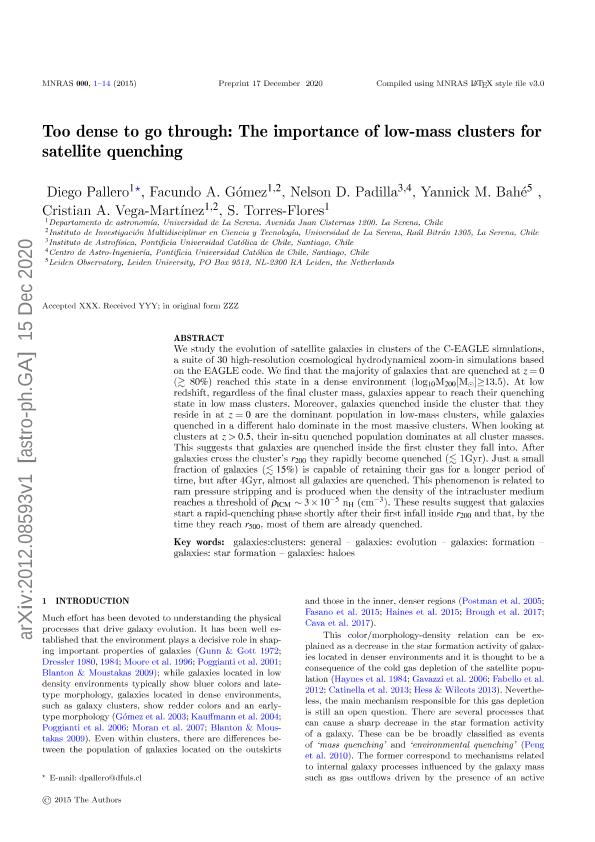Mostrar el registro sencillo del ítem
dc.contributor.author
Pallero, Diego
dc.contributor.author
Gómez, Facundo Ariel

dc.contributor.author
Padilla, Nelson David

dc.contributor.author
Bahé, Yannick M
dc.contributor.author
Vega Martínez, Cristian Antonio

dc.contributor.author
Torres Flores, S.
dc.date.available
2023-07-10T13:37:35Z
dc.date.issued
2022-04
dc.identifier.citation
Pallero, Diego; Gómez, Facundo Ariel; Padilla, Nelson David; Bahé, Yannick M; Vega Martínez, Cristian Antonio; et al.; Too dense to go through: The role of low-mass clusters in the pre-processing of satellite galaxies; Oxford University Press; Monthly Notices of the Royal Astronomical Society; 511; 3; 4-2022; 3210-3227
dc.identifier.issn
0035-8711
dc.identifier.uri
http://hdl.handle.net/11336/202898
dc.description.abstract
We study the evolution of satellite galaxies in clusters of the C-EAGLE simulations, a suite of 30 high-resolution cosmological hydrodynamical zoom-in simulations based on the EAGLE code. We find that the majority of galaxies that are quenched at z = 0 (80 per cent ) reached this state in a dense environment (log 10 M 200 [M] ?13.5). At low redshift, regardless of the final cluster mass, galaxies appear to reach their quenching state in low-mass clusters. Moreo v er, galaxies quenched inside the cluster that they reside in at z = 0 are the dominant population in low-mass clusters, while galaxies quenched in a different halo dominate in the most massive clusters. When looking at clusters at z > 0.5, their in situ quenched population dominates at all cluster masses. This suggests that galaxies are quenched inside the first cluster they fall into. After galaxies cross the cluster's r 200 they rapidly become quenched (1 Gyr). Just a small fraction of galaxies (15 per cent ) is capable of retaining their gas for a longer period of time, but after 4 Gyr, almost all galaxies are quenched. This phenomenon is related to ram pressure stripping and is produced when the density of the intracluster medium reaches a threshold of ?ICM ?3 ×10 ?5 n H (cm ?3 ). These results suggest that galaxies start a rapid-quenching phase shortly after their first infall inside r 200 and that, by the time they reach r 500 , most of them are already quenched
dc.format
application/pdf
dc.language.iso
eng
dc.publisher
Oxford University Press

dc.rights
info:eu-repo/semantics/openAccess
dc.rights.uri
https://creativecommons.org/licenses/by-nc-sa/2.5/ar/
dc.subject
GALAXIES: EVOLUTION
dc.subject
GALAXIES: FORMATION
dc.subject
GALAXIES: HALOES
dc.subject
GALAXIES: STAR FORMATION
dc.subject
GALAXIES:CLUSTERS: GENERAL
dc.subject.classification
Astronomía

dc.subject.classification
Ciencias Físicas

dc.subject.classification
CIENCIAS NATURALES Y EXACTAS

dc.title
Too dense to go through: The role of low-mass clusters in the pre-processing of satellite galaxies
dc.type
info:eu-repo/semantics/article
dc.type
info:ar-repo/semantics/artículo
dc.type
info:eu-repo/semantics/publishedVersion
dc.date.updated
2023-07-06T11:29:16Z
dc.journal.volume
511
dc.journal.number
3
dc.journal.pagination
3210-3227
dc.journal.pais
Reino Unido

dc.journal.ciudad
Oxford
dc.description.fil
Fil: Pallero, Diego. Universidad de La Serena; Chile. Universidad de Valparaíso; Chile
dc.description.fil
Fil: Gómez, Facundo Ariel. Universidad de La Serena; Chile
dc.description.fil
Fil: Padilla, Nelson David. Universidad Católica de Chile; Chile. Pontificia Universidad Católica de Chile; Chile. Consejo Nacional de Investigaciones Científicas y Técnicas. Centro Científico Tecnológico Conicet - Córdoba. Instituto de Astronomía Teórica y Experimental. Universidad Nacional de Córdoba. Observatorio Astronómico de Córdoba. Instituto de Astronomía Teórica y Experimental; Argentina
dc.description.fil
Fil: Bahé, Yannick M. Sterrewacht Leiden; Alemania
dc.description.fil
Fil: Vega Martínez, Cristian Antonio. Universidad de La Serena; Chile. Consejo Nacional de Investigaciones Científicas y Técnicas; Argentina
dc.description.fil
Fil: Torres Flores, S.. Universidad de La Serena; Chile
dc.journal.title
Monthly Notices of the Royal Astronomical Society

dc.relation.alternativeid
info:eu-repo/semantics/altIdentifier/doi/http://dx.doi.org/10.1093/mnras/stab3318
dc.relation.alternativeid
info:eu-repo/semantics/altIdentifier/url/https://academic.oup.com/mnras/article-abstract/511/3/3210/6430177?redirectedFrom=fulltext
dc.relation.alternativeid
info:eu-repo/semantics/altIdentifier/arxiv/https://arxiv.org/abs/2012.08593
Archivos asociados
